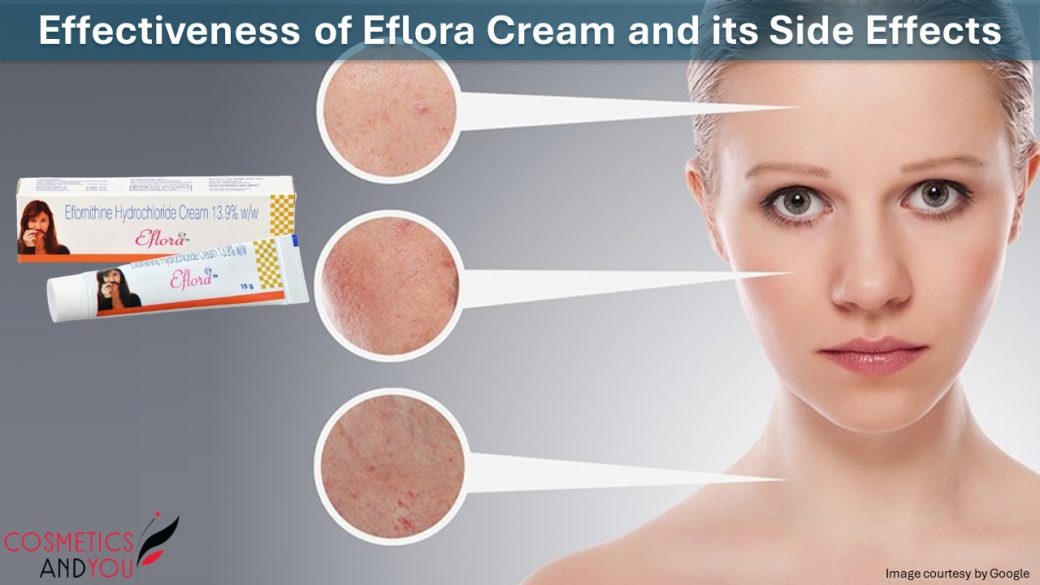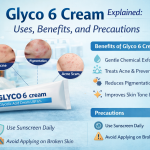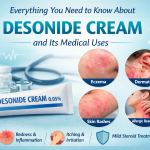Eflora cream is a prescription topical medicine applied to the skin to reduce unwanted facial hair in women. It has only been studied on the facial skin and adjacent areas under the chin of affected individuals. Let’s explore the drug’s effectiveness, usage, side effects, and precautions below.
Effectiveness of Eflora cream in facial hirsutism
Facial hirsutism is a cosmetic concern for females and can contribute to significant anxiety and lack of self-esteem. Eflora cream containing Eflornithine is prescribed to treat facial hirsutism. However, limited success rate and overall patient satisfaction, even with long-term usage and high-frequency application, leave room for improvement. Management of facial hirsutism usually comprises the combination of medical treatment and mechanical removal of the excessive hair. Mechanical techniques such as waxing, shaving, threading, plucking, and chemical depilatories are used regularly. Permanent hair removal using laser has also proven successful but is also associated with some disadvantages, including the high costs due to multiple procedures, pain, and the risk of scarring. Eflornithine was found to reduce facial hair growth and was approved by the Food and Drug Administration (FDA) for topical treatment of facial hirsutism. Twice daily application has been shown to reduce the length and hair mass compared to other treatments.
Usage instructions for best results
Apply a thin layer of this medicated cream to the affected areas of the face and surrounding areas under the chin and rub thoroughly until the cream gets absorbed into the skin. Don’t wash the treated areas for at least four hours. Use two times a day at least eight hours apart. Using the hair removal methods as required in conjunction with Eflora cream is advised. Apply the topical medication at least five minutes after hair removal. Sunscreens and other cosmetics may be applied over the treated areas, but wait a few minutes before allowing the medication to be absorbed. Eflora cream may cause temporary rash, redness, stinging, or burning sensation, especially when the skin is damaged. If skin irritation continues, discontinue using Eflora cream and contact yoru health care specialist. Avoid getting the cream in your eyes, rinse thoroughly with water, and contact your health care specialist.
Eflornithine cream doesn’t permanently damage hair or cure hirsutism (unwanted facial hair growth). Your treatment regimen should include continuing any hair removal method you currently use. The topical medication will help you manage your condition and improve your appearance.
Improvement occurs gradually, so don’t be discouraged if you do not see any improvement. One needs to be patient; improvement may be seen as early as 4 to 8 weeks of treatment. It may take longer for some individuals to see improvement. Discontinue usage if there is no visible improvement after six months. Research shows that in about eight weeks after stopping this topical treatment, the hair will return to the same condition as before starting treatment.
Side effects of Eflora cream
There are some common side effects of the Eflornithine cream, and they are as follows-
- Hives
- Breathing problems
- Severe irritation of treated skin
- Swelling of your lips, tongue, and throat
- Redness or crusting around your hair follicles
Get medical help if you notice any of the symptoms mentioned above. These are serious side effects that require immediate attention from physicians. There are some common side effects of the cream, and they are as follows:
- Application site skin reactions (burning, stinging, tingling, and redness, and skin
- Acne, or
- Hair bumps (folliculitis)
Seek immediate medical help if you experience any of the symptoms given below:
- Sometimes, there is sudden vision loss, blurred vision, tunnel vision, eye pain or swelling, or seeing halos around lights;
- Serious heart symptoms such as fast, irregular, or pounding heartbeats; fluttering in your chest; shortness of breath; and sudden dizziness, lightheadedness, or passing out;
- Severe headache, confusion, slurred speech, arm or leg weakness, trouble walking, coordination loss, unsteady, stiff muscles, high fever, profuse sweating, or tremors.
After seeing all your case’s benefits and side effects, your doctor may prescribe this medication. However, if you develop any symptoms of a serious allergic reaction, including rash or swelling in the face, tongue, or throat, get medical help immediately. The symptoms related to the heart are very serious, and they require immediate medical attention.
Precautions for safe usage of Eflora cream
Speak to your dermatologist before using the medicine and tell him about all the allergic reactions to Eflornithine or if there are any other allergies you experience. An ingredient such as methylparaben can cause allergic reactions or other problems, so consult your doctor before using this cream. It is not known if the topical medication interacts with other topical products. Discontinue treatment if hypersensitivity occurs. If you are pregnant or plan to become pregnant, discuss with your healthcare professional whether you should use Eflora cream during pregnancy. No research studies have been performed on pregnant women. If breastfeeding, speak to your doctor before using this hair removal cream. It is not known if the medication is passed into the breast milk.
Keep Eflora out of the reach of children and store it at room temperature between 15 and 30 degrees C. Throw away any expired medicine.





